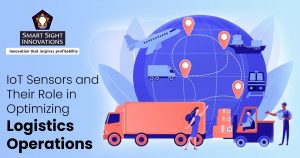 IoT is a network of physical items, including machines, cars, buildings and other things equipped with sensors, software and network connectivity. This technology enables connected devices to gather and share data. Smartphones, smart thermostats, wearable fitness trackers, industrial robots, etc. are all examples of IoT devices.
IoT is a network of physical items, including machines, cars, buildings and other things equipped with sensors, software and network connectivity. This technology enables connected devices to gather and share data. Smartphones, smart thermostats, wearable fitness trackers, industrial robots, etc. are all examples of IoT devices.
IoT is crucial for supply chain management and logistics, as it can give real-time information on how assets and items move through the supply chain. Its technology increases efficiency, visibility and automation eventually resulting in cost savings and customer satisfaction, thus transforming logistics operations.
Benefits of Using IoT in Logistics Operations
As the global supply chain network is undergoing a remarkable change, there is a demand for using smart and connected systems that can connect, predict and interact with the physical world to assess situations and offer solutions. One of the most widely used solutions is IoT technology, which benefits the supply chain sector in several ways. Below are some benefits of using IoT in logistics:
1. Inventory Management
Inventory management, a vital feature of the supply chain system involves ensuring enough supplies on hand to fulfill requests and arranging orders for prompt delivery. With an IoT-enabled inventory system, you can track the status of your inventory and the real-time supply levels.
Based on this information you can make smart business decisions and plan future inventory needs, thereby avoiding product shortages. Without any manual effort, IoT makes it simple to update asset information and also helps you keep a check on your product’s physical characteristics, such as leaks, damage and defective packing.
You can also get immediate access to crucial details about each delivery, such as the contents in the packages and storage instructions.
2. Transparency
IoT brings about transparency and avoids disruptions. By implementing IoT, you can monitor delivery personnel and shipping efforts to see if they adhere to company regulations.
You can be certain that the item is properly stored and avoid delays in getting products from the warehouse to the customer’s door. You can interact with your customers effectively and keep them updated at all times when you have real-time access to information.
3. Managing the Last-Mile Delivery
The distance from the local distribution center to the final destination, also known as the last-mile delivery, is generally the most expensive part of the distribution process and takes up 53% of the overall shipping costs. It can be a complex process as it involves challenges such as limited visibility and reduced efficiency.
GPS, real-time tracking and IoT sensors on vehicles can help logistics organizations shorten delivery times, lower costs and enhance customer satisfaction.
4. Fleet Management
By installing IoT sensors on your fleet of vehicles you can monitor the maintenance requirements of the vehicles and receive alerts if there are any issues. Additionally, you can receive immediate reports on the health of the driver and the state of the road so that you can enhance your fleet management strategy.
5. Predictive Management
IoT sensors can be used to track the health of machines and equipment, giving businesses the ability to foresee when a repair is necessary, thus reducing downtime, preventing malfunctions and increasing productivity. By gathering and analyzing real-time data from the machinery and equipment utilized in the logistics process, IoT devices can be used for predictive maintenance in the logistics industry.
It can analyze this data to find patterns and abnormalities that could point to problems or equipment failures. Trucks and other vehicles, for instance, can be fitted with sensors to gather information on fuel usage, tire pressure and engine performance.
Similar sensors can be installed on forklifts and conveyor belts in warehouses to track usage and effectiveness. Based on the trends and patterns, prospective maintenance issues can be pointed out.
Logistics businesses can then forecast maintenance requirements and plan replacements or repairs before any failures. This decreases downtime and additional expenses while also enhancing equipment performance and lengthening its life.
Global brands quickly recognized the advantages of IoT and began implementing this technology to further enhance their supply chain management and logistics procedures. For instance:
- Amazon improved the operation of its warehouses by using IoT sensors that can scan QR codes and identify merchandise. Automation enabled it to use its workforce more efficiently, cut operating expenses and enhance general warehouse efficiency.
- Maersk, a Danish shipping and logistics firm, introduced a technology called Remote Container Management. This IoT device helps operators prevent perishable items from getting spoiled, cut down on waste and increase the accuracy of transportation schedules by constantly monitoring the temperature and humidity in shipping containers.
- DHL uses IoT and wearables to make the workplace safer for on-site workers. This helps check staff rest levels, better coordinate breaks and working hours and reduce stress levels.
How Can IoT Sensors Be Used?
Using IoT devices throughout the supply chain, from manufacture to transportation to distribution allows visibility and data collection and delivers real-time insights. This information allows logistics firms to make data-driven decisions that can improve customer happiness, cut costs and enhance the supply chain.
It also helps in identifying problems and disorganization quickly and enables the supply chain managers to respond to them on time. Here are some ways how these devices can improve it:
- RFID (Radio Frequency Identification) tags can be used to trace the movement of products through the supply chain. IoT-enabled devices can read the tags and transfer the information to a centralized system for timely monitoring and reduce the risk of shortages.
- With the help of the GPS tracking systems, items moved through the supply chain can be monitored and immediate information regarding the movement can be sent to a centralized system. This can help track shipments, estimate delivery times and identify faster routes.
- IoT sensors can monitor the temperature and humidity conditions of goods as they pass through the supply chain. By using this information, shipping routes can be made more efficient, damage to goods can be prevented and appropriate conditions can be maintained for the transportation of perishable commodities and medicines.
- As items transit through the supply chain, IoT sensors can continuously track their condition. For instance, sensors can identify whether a package has been tampered with or if there has been product spillage.
- IoT devices can be used to send out prompt signals to stakeholders about any problems or delays regarding the commodities moving through the supply chain.
- Wearable devices help in tracking the activities and movements of warehouse workers. This information aids in optimizing staff productivity and also prevents workplace injuries while increasing worker safety.
IoT devices contribute extensively to a more effective and streamlined logistics management strategy. It captures and sends data using sensors to offer a wide range of advantages, such as effectively transmitting data, maintaining proper storage conditions, route optimization, monitoring the vehicle’s location with the help of GPS and delivery time estimation.
It can also improve communication procedures, by using real-time digital contact. IoT together with several other technologies like low-latency 5G networks, AR, drones, autonomous vehicles, blockchain and smart warehouses can create a tremendous impact on optimizing logistics operations.














